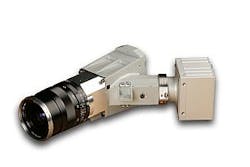The V10M hyperspectral imaging sensor for unmanned aerial vehicles and other applications operates from 380 to 1000 nm with negligible sub-pixel distortions. It has spatial resolution of 2000 pixels, and takes 100 images each second, faster with spectral binning. It weighs <0.9 kg and fits small payload compartments and gimbals.
Specim, Spectral Imaging Ltd.
Oulo, Finland
www.specim.fi
-----
PRESS RELEASE
SPECIM's Revolutionary Hyperspectral Imaging Sensor Takes off
Oulu, Finland; April 6, 2010 - SPECIM, Spectral Imaging Ltd, the world's leading manufacturer of hyperspectral imaging components and systems, responds to market demand and launches a new high resolution hyperspectral imaging sensor with exceptional performance and the dimensions required for Unmanned Aerial Vehicles (UAV) and other challenging applications.
The new V10M sensor operates in the VIS/NIR range of 380 - 1000 nm, and provides superior spectral and spatial imaging with negligible sub-pixel distortions (smile, keystone). The current sensor has an excellent spatial resolution of 1300 pixels, and a 2000 pixel version will be released later this year. The high resolution does not compromise the imaging speed, which reaches 100 images/s, and even higher rate with spectral binning. Superb optical light throughput, together with the most advanced and sensitive detector technology available, guarantees an excellent signal-to-noise ratio. The specifications meet the most demanding requirements for target detection with a wide swath width for efficiency in airborne uses, as well as provide superior performance in industrial quality control applications. The extreme performance from a light weight sensor of less than 0.9 kg (2 lb), including the spectrograph and camera, and in a format optimized to fit to small payload compartments and gimbals is the signature of the new M series sensors.
The sensor is based on the latest development in SPECIM's market leading ImSpector series of imaging spectrographs, the ImSpector M series. This compact new technology is particularly designed to increase the spatial resolution of push-broom hyperspectral imagers, and works with detector arrays up to 24 mm wide in the spatial dimension. The design is optimized for operation in harsh conditions, and provides the option of a user exchangeable fore optic.
"Current hyperspectral imagers are either bulky with good performance, or compact, with only moderate performance. With the introduction of the new M Series, SPECIM overcomes these drawbacks, and offers clients in defense, security and industrial applications an off-the-shelf hyperspectral sensor that out performs all other sensors in the market. The M Series VIS/NIR sensor is the first step, which will be followed by the introduction of a high resolution SWIR sensor, as well a high performance, miniaturized cooled LWIR sensor in the near future. They will elevate the use of high performance hyperspectral imaging in the market place to new levels, while adding increasing value to our clients products. " says Timo Hyvärinen, Managing Director of SPECIM.
For further information, SPECIM welcomes you to visit the booth No. 211 at SPIE Defense, Security+Sensing (DSS) exhibition in Orlando, FL, USA, 6-8 April, 2010, where the new M Series hyperspectral sensor will be displayed. The booth is hosted by both SPECIM and our partner SpecTIR LLC. Alternatively, please contact SPECIM, Spectral Imaging Ltd (tel +358 10 4244 400, email: [email protected]), and in the US, SpecTIR LLC (410 820 5591, email: [email protected]).
Posted by Lee Mather
Subscribe now to Laser Focus World magazine; it's free!
